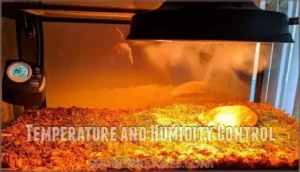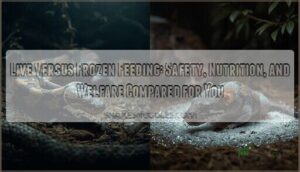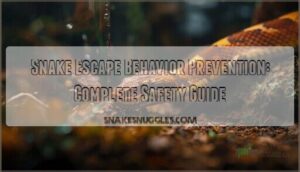This site is supported by our readers. We may earn a commission, at no cost to you, if you purchase through links.

When you understand how desert, tropical, and temperate species regulate their body temperature and moisture levels in the wild, you’ll know exactly which environmental parameters matter most for keeping your snake healthy through every season.
Table Of Contents
Key Takeaways
- Your snake’s native habitat determines its survival in captivity—a ball python from tropical West Africa requires precise temperature gradients (75-85°F) and humidity levels (60-80% for tropical species, 30-50% for desert species) that you’ll need to replicate regardless of whether you live in Montana’s cold or Florida’s humidity.
- Seasonal adjustments aren’t optional extras but physiological necessities—metabolism slows during cooler months affecting feeding frequency and digestion, while climate extremes like winter frost or summer heat demand backup heating systems and constant monitoring to prevent respiratory infections, dehydration, and metabolic collapse.
- Substrate choice directly impacts thermoregulation and health outcomes—aspen shavings work for arid species, cypress mulch maintains humidity for tropical snakes, and mismatched substrate moisture levels cause scale rot in 11.2% of captive snakes and shedding complications in 28.2%.
- Climate change is actively reshaping snake care requirements—wild populations show winter survival declines since 1987, range shifts forcing species northward, and up to 70% habitat loss in tropical zones, making conservation-minded ownership and proper husbandry records increasingly critical for species preservation.
Snake Habitats and Climate Adaptations
Snakes have colonized nearly every corner of the planet, from scorching deserts to humid rainforests, and each environment has shaped how these reptiles survive.
Knowing where snakes live in the wild and how they handle extreme conditions helps you set up the right habitat for your pet.
From global deserts to dense rainforests, snakes have adapted to thrive in remarkably different climates. Understanding these natural habitats—and the physical traits that help snakes survive extreme heat or cold—gives you practical insight for creating the right environment for your pet.
Global Distribution of Snake Species
Across the globe, you’ll find snakes thriving in nearly every habitat imaginable—over 3,900 species have been documented as of September 2025. Their geographic range spans all continents except Antarctica, with tropical regions like Mexico (438 species) and Brazil (420 species) leading in species diversity. Understanding this global distribution helps you appreciate the extraordinary environmental adaptation that shapes snake care requirements.
- Climate zones matter: Tropical rainforests in South America and Southeast Asia harbor the densest snake populations, while temperate regions like Europe support fewer than 50 species.
- Habitat preferences vary widely: From desert specialists like sidewinders to aquatic giants like anacondas in wetland systems, each species evolved for specific conditions.
- Conservation status reflects threats: Over 75% of Mexican snakes are endemic, making habitat preservation critical as climate change shifts traditional ranges.
The study of snake population trends is essential for understanding the complex relationships between species and their environments.
Environmental Challenges in Different Regions
Knowing where snakes exist globally is one thing—understanding what helps them survive is another. Mountain ranges and oceans act as natural dividers, separating snake populations and pushing them to develop traits specific to their isolated regions.
These same forces create environmental hurdles that vary dramatically: desert snakes must tackle extreme heat and water shortages, while tropical species face the opposite challenge of managing constant moisture.
Temperature regulation is critical, especially in extreme cold where hypothermia threatens captive snakes. Habitat issues, including the impact of climate change, exacerbate water scarcity and thermal stress across all regions. Proper snake care involves understanding thermal gradient management to ensure the health and well-being of the snakes.
| Region Type | Primary Challenge | Key Stressor |
|---|---|---|
| Arid/Desert | Water scarcity, extreme heat | Dehydration risk (4% body mass loss triggers thirst) |
| Cold/Temperate | Hypothermia, insufficient insulation | Winter survival rates dropped markedly since 1987 |
| Tropical/Humid | Overheating, humidity control | Activity increases with temperature and humidity rises |
| Mixed Climate | Seasonal fluctuations | Disrupted shedding cycles, immune suppression |
Natural Adaptations to Climate Extremes
Snakes haven’t just survived extreme climates—they’ve evolved extraordinary solutions. Desert adaptations include genetic changes in kidney function and skin permeability, reducing water loss in arid conditions.
Thermoregulation drives behavioral choices: snakes alternate between sunbathing and shade-seeking to maintain ideal body temperature. Thermal tolerance varies widely; some species thrive at temperatures up to 60°C, while others demonstrate climate resilience through broad locomotor performance across 15°C to 36°C ranges.
From modified TRPA1 thermosensors that detect heat to streamlined bodies that slip into underground refuges, snakes pack some impressive evolutionary tricks—and understanding these adaptations is key to creating proper captive environments.
Creating The Ideal Enclosure Environment
Your snake’s enclosure isn’t just a container—it’s a controlled environment that replaces the natural habitat your pet would navigate in the wild.
Getting the fundamentals right means understanding how temperature, humidity, substrate, and enrichment work together to support your snake’s physiological needs.
Here’s what you need to know about each essential component for a thriving setup.
Temperature and Humidity Control
Think of your snake’s enclosure as a carefully calibrated microhabitat. Get the temperature and humidity wrong, and you’re not just making your pet uncomfortable, you’re risking its life.
You’ll need to establish a proper temperature gradient with heat sources like heat lamps on one end, allowing thermoregulation through behavioral choices. Most species thrive when climate zones range from 75°F in cooler areas to 85°F basally, while humidity levels depend on your snake’s native habitat—desert species need 30-50%, tropical ones 60-80%.
Monitor constantly to prevent temperature fluctuations that disrupt digestion and immunity.
Learn How to Keep The Enclosure Warm
You have three primary heating methods at your disposal: under-tank heating pads, ceramic heat emitters, and radiant heat lamps—each with distinct advantages depending on your snake’s thermoregulatory behavior. Heat mats provide belly warmth for fossorial species, while heat lamps create vertical thermal gradients that mimic solar radiation.
You’ll need thermostats to keep temperatures safe and prevent overheating, while proper insulation helps distribute warmth evenly throughout the enclosure—no matter where you live.
This setup lets your snake move between warm and cool zones to regulate its body temperature naturally.
Choosing The Right Substrate
The substrate you pick affects how well your snake regulates temperature, holds humidity, and stays healthy overall—it’s one of the biggest choices you’ll make after getting your heating sorted out.
Your bedding needs to match what your snake would find in the wild and help you control the tank’s environment.
Consider these primary options for ideal habitat management:
- Aspen shavings excel for arid species, offering temperature regulation without excessive moisture retention
- Cypress mulch maintains humidity control for tropical species while preventing bacterial growth
- Paper-based substrates simplify enclosure design while allowing precise monitoring of waste and health indicators
Match your tank linings to species-specific moisture levels—desert dwellers like hognose snakes thrive on dry substrates, while rainforest species require consistently damp soil quality for proper shedding and hydration.
Safe Decor and Enrichment
Good enrichment turns a basic enclosure into a space where your snake can actually thrive and act like a snake.
Choose decorations that give your pet hiding spots and security while keeping temps and humidity stable—think branches if you’ve got a climbing species, hides on both the warm and cool sides for temperature control, and a water dish big enough for soaking when it’s time to shed.
Your enclosure design and maintenance should prioritize safety—avoid sharp edges, secure all decor against collapse, and ensure enrichment toys don’t interfere with heating elements or create escape routes.
| Enrichment Category | Function | Species Considerations |
|---|---|---|
| Snake Hides | Thermoregulation and security | Provide warm-side and cool-side options |
| Water Features | Hydration and humidity maintenance | Size according to species body mass |
| Climbing Structures | Exercise and behavioral expression | Essential for arboreal species |
| Substrate Options | Burrowing opportunities | Match to natural habitat requirements |
Caring for Snakes in Varying Climates
Your snake’s climate needs don’t stop at the enclosure setup—they shift with the seasons and local weather. Whether you’re battling winter frost or summer heat, understanding how temperature swings affect feeding, hydration, and brumation keeps your snake healthy year-round.
Here’s how to adjust your care routine as the weather shifts.
Snake Care in Cold Climates
When winter’s chill settles in, your snake doesn’t simply shrug off the cold—its entire metabolism shifts into a slower gear that demands careful attention from you as its keeper. Reduce feeding frequency as your snake’s appetite naturally declines, and monitor for frostbite prevention by ensuring consistent temperature regulation throughout the enclosure.
You’ll need reliable heating solutions like heat mats or heat lamps to maintain a thermal gradient between 75 and 85 degrees Fahrenheit.
Snake Care in Warm and Tropical Climates
{{
Seasonal Adjustments and Hibernation
Most temperate species naturally undergo brumation—a period of reduced metabolic activity lasting anywhere from one to eight months depending on ambient temperature, age, and overall health. Understanding hibernation patterns helps you support proper seasonal cycles and winter survival.
During brumation, snakes exhibit impressive thermoregulation, maintaining body temperatures just above freezing while heart rate and respiration slow dramatically.
Climate adaptation varies by species: timber rattlesnakes typically lose around 3.6% body mass, while juveniles face mortality rates exceeding 20% without careful environmental adaptation and temperature regulation.
Water Needs and Dehydration Prevention
While your snake’s energy needs drop during brumation, maintaining proper hydration year-round remains one of the most overlooked aspects of reptile husbandry. Research shows Nerodia species begin drinking behavior after just 4% body mass loss—a critical threshold you’ll want to avoid.
Watch for sunken eyes, wrinkled skin, and reduced activity as dehydration signs. Provide clean, dechlorinated water daily while monitoring humidity control between 50-70% depending on species requirements for ideal thermoregulation.
Monitoring Health and Behavior Changes
Your snake’s behavior tells a story—you just need to know how to read it. Environmental stress, appetite shifts, and behavioral changes often signal underlying issues before they become serious problems.
Here are the key indicators that help you spot trouble early and keep your snake thriving.
Signs of Environmental Stress
Your snake’s behavior tells a story—you just need to know how to read it. Watch for these Environmental Signs indicating stress or Habitat Issues:
- Lethargy or excessive hiding – Poor Temperature Regulation forces your snake to conserve energy beyond Thermal Limits
- Refusal to eat – Climate Effects directly alter metabolism and Stress Behavior
- Frequent soaking or restlessness – Signals humidity problems affecting Snake Health and Behavior
- Respiratory distress – Critical Health Indicators of Environmental Changes and Snake Adaptation failure requiring immediate attention
Recognizing these signs protects Animal Welfare.
Feeding Patterns and Appetite Changes
Temperature shifts don’t just change your snake’s comfort level—they rewire its entire feeding schedule and appetite. In cooler conditions, metabolism slows, extending Feeding Cycles and reducing Appetite Regulation. You’ll notice your snake refusing meals or taking longer to digest—both normal responses to Temperature Regulation changes.
Getting these dietary needs right lets you fine-tune portions and feeding times, which directly supports your snake’s nutritional balance and overall behavior.
When you match diet to climate conditions, you’re actively protecting your snake’s welfare through smart reptile management.
Handling Moves and New Environments
Moving your snake to a new home or adjusting its enclosure setup can trigger stress responses that ripple through its eating habits, activity levels, and overall sense of security. Environmental Acclimation requires patience—your snake needs time to map its new territory and reestablish temperature regulation patterns.
Support this Habitat Shift by:
- Maintaining consistent temperature gradient and humidity from day one
- Minimizing touching for the first week to reduce Relocation Stress
- Keeping feeding schedules predictable during Climate Adjustment
Proper Snake Transport and enclosure setup help your snake adapt to caring for snakes in different environments through effective habitat management.
Preventing Common Health Issues
Control Respiratory Care and Scale Health by matching your enclosure’s temperature gradient and humidity levels to your snake’s native climate. Suboptimal conditions cause 5.6% of captive snakes to develop respiratory problems, while 11.2% experience skin infections like scale rot.
Dehydration Prevention requires maintaining humidity above 65% for tropical species; inadequate moisture triggers appetite loss and compromises Skin Shedding, with 28.2% of snakes experiencing retained shed complications. Monitor these parameters daily through Infection Control protocols and proper temperature regulation.
| Health Issue | Primary Environmental Cause | Prevention Strategy |
|---|---|---|
| Respiratory infections | Suboptimal core temperature, poor ventilation | Maintain species-specific thermal gradient with adequate airflow |
| Scale rot | Excessive humidity, damp substrate | Use appropriate substrate; guarantee proper drainage and ventilation |
| Dehydration | Low humidity ( Climate control is your snake’s invisible life support—without it, even healthy specimens risk infections, dehydration, and metabolic collapse |
When you commit to monitoring those parameters daily and adjusting them seasonally, you transform captivity from mere survival into genuine thriving—giving your snake the physiological stability it needs regardless of whether snowdrifts or heat waves wait outside.
- https://journals.plos.org/plosone/article?id=10.1371%2Fjournal.pone.0300363
- https://masonlab.ib.oregonstate.edu/sites/masonlab.ib.oregonstate.edu/files/091patternsmortalitycoldclimate.pdf
- https://www.mass.gov/news/snakes-are-preparing-for-winter
- https://pmc.ncbi.nlm.nih.gov/articles/PMC7938798/
- https://redinational.com/can-weather-conditions-affect-snake-activity-in-your-area/












